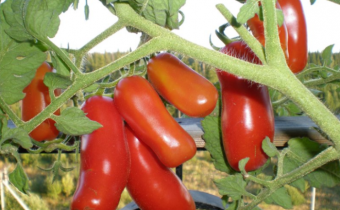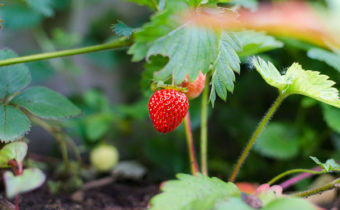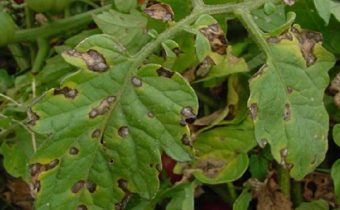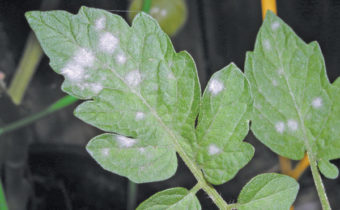Late blight on tomatoes, what to do?
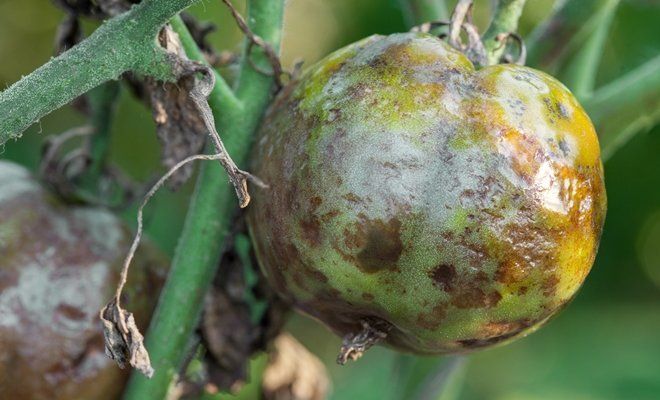
Late blight - a disease that vegetable growers often face. It indicates improper development of the fruit, errors that were made in the process of leaving, as well as adverse weather conditions.
Its appearance can lead to a significant loss of harvest. How to prevent its spread on the site?
Symptomatology
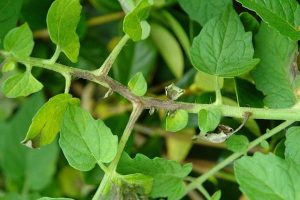 Like any disease of tomatoes, late blight has symptoms that indicate its occurrence. There are a lot of them:
Like any disease of tomatoes, late blight has symptoms that indicate its occurrence. There are a lot of them:
- the emergence of downspace on the stems and the inner sides of the foliage;
- Tomatoes become ugly and do not have time to ripen;
- dark spots appear on the fruits, which can form large areas of damage;
- when biological maturity is reached, tomatoes remain hard, but as the disease progresses, they become soft, begin to rot, and the corresponding odor appears;
- usually the disease occurs on the lower leaves, and then moves to the upper ones;
- flowers and peduncles become blackish and dry;
- the spots themselves are hard, affecting not only the surface but also the inside of the fruit.
Causes
Late blight refers to fungal diseases, therefore comfortable conditions for its occurrence are:
- large excess of lime in the soil;
- wet greenhouse conditions;
- sudden changes in temperature (they are often at the beginning and at the end of summer);
- heavy rains.
Tomatoes that do not have good nutrition and have lost their immunity are also exposed to late blight. If they, besides this, do not have enough iodine and potassium, then the chances of the occurrence of the disease increase. Late blight is carried by air from infected plants.
Disease prevention
To prevent such a disease bypassing the plot / greenhouse, carry out preventive measures.
Give preference to varieties that have a short ripening period. Forming tomatoes within 3 months, they manage to avoid the disease by this fungus.
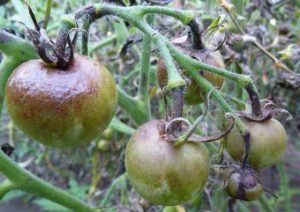 Not so afraid of late blight tall varieties. This is explained by the fact that the principle of removing the lower leaflets is used, and this ensures good ventilation and minimizes excess moisture. Good statistics show plants that are grown in greenhouses - there are maintained certain temperature and humidity, which is pleasant to tomatoes.
Not so afraid of late blight tall varieties. This is explained by the fact that the principle of removing the lower leaflets is used, and this ensures good ventilation and minimizes excess moisture. Good statistics show plants that are grown in greenhouses - there are maintained certain temperature and humidity, which is pleasant to tomatoes.
If last year late blight visited the garden, then in the fall cleaning should be done carefully - the remnants of plants need not only to be collected, but also burned, and tools should be carefully processed. When approaching dangerous periods, it is necessary to carefully monitor the care of the plants: prevent moisture from falling on the foliage, ensure proper feeding, etc. An important preventive measure is to remove the lower leaves, because late blight appears on them. Sore seedlings should be removed immediately. If you have noted that this disease has passed on the neighboring plots, then do not wait until it hits the rest - it is better to immediately remove the tomatoes and leave the fruits to ripen.
Treatment of late blight
Since the primary signs of the occurrence of phytophthora on tomatoes are a sign that the disease is progressing, that is, the fungus has already been present in tomatoes for a substantial time, the struggle should begin in advance.
Chemicals
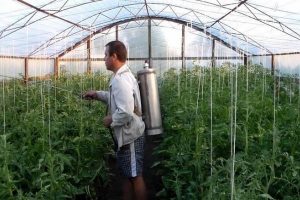 Usually they do this when lowering the temperature to +10 (strong dew occurs on the seedlings) or when it rains for a long time. It happens in June, in August, and in September.
Usually they do this when lowering the temperature to +10 (strong dew occurs on the seedlings) or when it rains for a long time. It happens in June, in August, and in September.
Picking up drugs in the store, remember that late blight acquires immunity to chemicals. Perform treatment every seven days, changing the means. Extreme irrigation is carried out no later than 3 weeks before fruit harvesting.
Microbiological products
They are also quite effective. The present bacteria are quite active fighting for the fungus, as well as destroying microbes of other pathogens.
They do not completely destroy rot, so these tools must be used in conjunction with others.
Folk remedies
Ash
350 gr. boil the ashes on low heat for about half an hour and leave in water. Let it stand, then strain and add 10 liters of water. Do not forget to add a little rubbed soap (enough grams 20).
Rotten straw
1 kg of rotten straw or hay add to 10 liters of water, do not forget about a handful of urea. Leave it all to insist for 3-4 days. After that you can spray, but not more than 1 time in 10 days.
Pine shoots
No less common means. Finely chop the shoots, then boil them for a few minutes in 0.4 liters of water. Let the broth cool, then dilute it with clean water in a ratio of 1 to 5 and you can spray the tomatoes.
Varieties resistant to late blight
Quite a lot of varieties that are characterized by appropriate resistance to late blight.
Cardinal
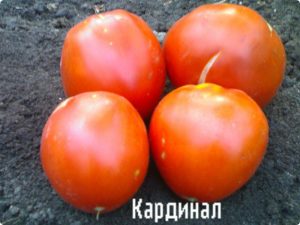 Variety refers to the medium - tomatoes ripen usually within 3 months. Bush high - up to 1.7 m, so it requires pasynkovanie. The fruits are quite large (200-600gr), so the plant must be tied up.
Variety refers to the medium - tomatoes ripen usually within 3 months. Bush high - up to 1.7 m, so it requires pasynkovanie. The fruits are quite large (200-600gr), so the plant must be tied up.
Grade advantages:
- not afraid of the cold;
- comfortable with temperature drops;
- fruits are universal in use.
Japanese creeping
Low plants that reach an increase of up to 30 cm. It is characterized by the fact that the branches are spread in different directions. Tomatoes of medium size (100-200 g), are located on each branch. Fruits are well stored, transported, high yield - more than 5.5 kg.
Betta
Compact variety, height - up to 50 cm. Matures in 85 days. Compact tomatoes - 50-70 g, round shape. The yield of the variety is low - up to 2 kg, suitable for growing both on the windowsill and in the open field.
Grade advantages:
- excellent taste properties;
- universality in application;
- good for transportation;
- long bears fruit.
Minion of fortune
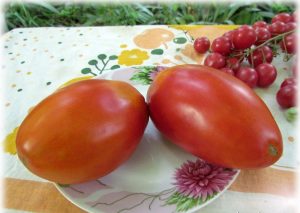 This variety is characterized by early ripening. The height is not more than 1 meter, but still it is recommended to carry out the pinching. Fruits are medium (150-200 g), the skin is dense. The yield is low - up to 2.5 kg, but has excellent taste properties.
This variety is characterized by early ripening. The height is not more than 1 meter, but still it is recommended to carry out the pinching. Fruits are medium (150-200 g), the skin is dense. The yield is low - up to 2.5 kg, but has excellent taste properties.
Advantages:
- friendly tomato ripening;
- excellent transportability;
- universality in use.
Annie
The variety is famous for precocity and excellent resistance to late blight. The period of formation of the variety takes up to 95 days, which makes it possible to get the crop twice per season.
The plant itself has a fairly small growth of up to 70 cm, the stem is powerful, so the garter is usually not required, but still it is better to do it.
Grade advantages:
- compact size of the bush;
- fast ripening;
- fruits are not prone to cracking;
- excellent transportability.
Proper preparation and selection of varieties will help you reduce the likelihood of late blight to a minimum, however, do not forget about this disease, because the earlier you can identify it, the greater the chance of saving the crop.


